After eliminating Search Traffic Errors, the next step is to optimize your site’s performance in the Google Index section of Google Search Console (GSC). In general, this section will provide you with the tools to fine-tune how you want your site to be indexed, check significance of content keywords, ensure that resources the Googlebot may need are not blocked, and remove URLs that are of little relevance in searches.
Index Status
When users search the Internet for something, the results are returned quite quickly. The reason for this is quite simple: Google has indexed thousands, if not millions, of web pages so that it already knows what’s out there. When a search is performed, the indexed pages that are most relevant to the search query are checked and returned to the user’s search results.
As a website owner, you should know which of your website’s URLs have been indexed, which have not, and if there is a problem. The Index Status tool of GSC reports how many of your website’s URLs were found and added to Google’s index, how many are blocked intentionally by your robots.txt file, and how many URLs you have removed. If the count of indexed pages ever drops unexpectedly, there could be a problem with the page(s) and you need to investigate any issues. Your graph should show an upward trend in the number of indexed pages, which indicates that Google can access the pages of your site. Of course, before a website can be indexed, you need to submit a sitemap to Google. You can make one at XML-Sitemaps.com or use a Sitemap plugin.
Content Keywords
Have you ever wondered how well your content keywords are performing? The Content Keywords tool of GSC will do just that. It will return a list of your most significant keywords with a drill-down link to the pages those keywords appear on. Reviewing the keywords with the Search Queries report reveals how Google is interpreting the content of your site. Significance indicates how many times the keyword is found on your site (with the most significant listed first) and on which pages they appear.
If you see results for any unexpected words, such as “sex” or others, you should check your site for hacking. You will also want to check for Crawl Errors if any of your keywords are missing from the list. For example, if you are a restaurant that is known for sweet treats and cake, one of your significant keywords is likely to be “dessert.” If that word is missing from your list, it is likely that Google was not able to crawl and index a number of pages and checking for Crawl Errors can help solve the problem. Again, submitting a Sitemap can serve in reducing such errors.
Blocked Resources
Without access to some of your page’s resources, the Googlebot cannot index the pages of your site correctly. Your site’s robots.txt file should not disallow crawling of resources such as JavaScript, CSS, and image files because pages may not render or index correctly. Check that your robots.txt file is correct so it does not affect your page’s ranking.
At the top of the Blocked Resources report will be a list of files that may be impairing the indexing of your web page. Below the graph is a list of all the pages that may not be indexed properly. To correct this, click on the URL and go through the 3 steps in the pop-up window. The first is to see how Google views your page. The second step is to verify ownership of the blocked resource. The third step is to unblock items from the robots.txt file. More details on these steps are listed on the Blocked Resources Report help page.
Remove URLs
Pages that are not considered useful should be included in the robots.txt file to prevent crawling of content that does not add value to users coming from search engines. For example, if you have a search option on your site and someone uses it to find content on your site, a search results page is created. It’s possible that Google will index these pages and think your site is larger than it really is. The search results do not provide added value to your site and it will affect your Page Ranking. Varvy.com explains this concept really well.
For more information on GSC’s Index section, check out Google’s Search Console Help pages for more details.
UPDATE: At the time this article was written, it was reported by Google that the Index Status report was broken. A user found that their Sitemap report had increased but the Index Status report did not. Since the two reports usually align and shift together, Google suggests relying on your website’s Sitemap report for the time being. An estimated time for the Index Status report to be fixed has not been shared presently.
Based in Rochester, New York, Netsville is an Internet Property Management company specializing in managing the Digital Marketing, Technical, and Business Solutions for our customers since 1994. For more information, please click here.



